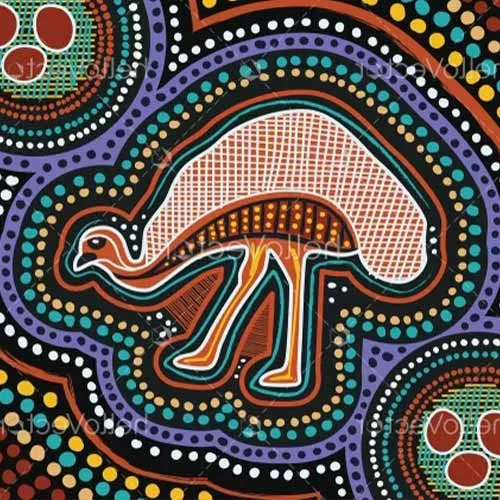

Australia, a land teeming with creatures that look like they were dreamed up in a feverish
artist’s sketchbook, is home to one bird that defies both gravity and expectations. Meet the
emu (Dromaius novaehollandiae), a creature of prehistoric charm, drum-like vocal prowess, and a tenacity once led it to wage an unlikely war against humans—and win.
A Bird That Forgot to Fly—But Didn’t Forget to Be Fabulous
The emu, the tallest bird in Australia and the third tallest in the world (only the common and Somali ostriches outgrow it), is a ratite—a peculiar category of large, flightless birds that includes the formidable cassowary and the gentle kiwi. Native to the vast Australian mainland, the emu is an evolutionary marvel, having adapted to thrive in environments ranging from open savannahs to wooded landscapes. Despite its inability to take flight, the emu is no slouch. This leggy wonder can sprint at speed of up to 50 km/h (31 mph), with strides stretching up to 9 feet (2.7 meters). If that weren’t enough, it also has endurance that would put most marathon runners to shame, capable of maintaining a steady pace across great distances in search of food, water, and, presumably, adventure.
A Diet of Champions (and Opportunists)
Emus, ever the resourceful foragers, sustain themselves on a balanced diet of insects, plants, seeds, and grasses. Their culinary preferences extend to beetles, crickets, and grasshoppers, though they’re not above snacking on whatever nature offers. Their dietary habits make the an essential component of Australia’s ecosystem, aiding in seed dispersion and pest control, albeit sometimes at the expense of farmers’ crops.
The Emu Wiggle: A Dance of Pure Joy
While the emu’s appearance might suggest a prehistoric toughness, these birds have an undeniably playful side. Domestic emus have been observed engaging in spontaneous wiggling dances when excited, a spectacle as bizarre as it is delightful. Imagine a seven-foot-tall bird doing a happy little shimmy—it’s the kind of quirky charm that solidifies the emu’s status as one of the most endearing birds on the planet.
The Drumbeats of a Dinosaur
As if emus weren’t already bizarrely fascinating, they also produce one of the eeriest sounds in the animal kingdom—a deep, resonant drumming noise that seems more fitting for prehistoric creature than a modern bird. This low-frequency drumming, created in an inflatable throat pouch, is the emu’s way of communicating, especially during mating season. Males, entranced by the seductive bass lines of the female’s call, step up for a romance that ultimately leaves them as single dads (more on that in a moment).
A Lesson in Unconventional Parenting
In the world of emus, gender roles take an interesting turn. After mating, the female lays a clutch of eggs—each one a glorious emerald green—and promptly exits the parenting equation. The responsibility of incubation and chick-rearing falls entirely on the male, who, in a display of unparalleled devotion, forgoes food, water, and bathroom breaks for nearly two months while he incubates the eggs. During this time, he survives purely on stored body fat, a feat of avian endurance that’s as noble as it is extreme. Once the chicks hatch, the father continues his role as protector, fiercely guarding his offspring from potential threats (which, amusingly, includes the very mother of his children, who is often met with hostility if she attempts to approach).
A Legacy of Survival and Resourcefulness
For millennia, the emu has been an essential part of Aboriginal Australian culture, providing food, leather, and a precious natural remedy—emu oil. Extracted from the bird’s fat, this oil has been used by Indigenous Australians for generations to treat wounds, relieve pain, and soothe inflammation. Packed with beneficial fatty acids, including oleic acid, linoleic acid, and palmitic acid, emu oil possesses remarkable healing properties. It is prized for its ability to deeply penetrate the skin, making it a sought-after remedy for arthritis, burns, and muscle pain. Today, it remains an important ingredient in modern cosmetics and therapeutic products, proving that the emu’s gifts go far beyond its quirky charm.

The Great Emu War: When Birds Outsmarted Bullets
Perhaps the most legendary chapter in emu history is the 1932 Great Emu War—a military campaign so spectacularly absurd that it has become the stuff of legend. That year, emus in western Australia, drawn to farmlands where food and water were readily available, began ravaging wheat crops. Farmers, exasperated by the avian invasion, called upon the government for assistance. Enter the Australian military, armed with Lewis machine guns and thousands of rounds of ammunition, determined to take down an army of feathered marauders. What followed was a comically ineffective series of encounters where the emus, proving themselves to be tactica geniuses, dodged bullets, outpaced military vehicles, and demonstrated an uncanny ability to evade traps. The campaign ultimately ended in failure, with the emus sustaining relatively few casualties while Australian troops withdrew in defeat. Historians and ornithologists alike have since marvelled at the event, with one observer noting that emus “can face machine guns with the invulnerability of tanks.” If nothing else, the Great Emu War proved that these birds, despite their oddball charm, are not to be underestimated.
Emus in Modern Times: Thriving, Farming, and Fashion Statements.
Today, emus continue to thrive across Australia, though climate change poses an emerging challenge to their habitat. They are also farmed for their meat, leather, feathers, and oil. Emu meat, known for being lean and high in protein, is classified as poultry but is often compared to beef due to its dark colour and similar pH levels. Their feathers have found a niche in decorative fashion, while emu oil is prized for its therapeutic properties, particularly in cosmetics and dietary supplements. Nothing goes to waste.
The Legacy of the Emu: A Symbol of Resilience and Quirkiness
The emu, with its prehistoric lineage, bizarre drumming sounds, and capacity for outwitting humans, is a true icon of the Australian wild. It struts (or wiggles) its way through life with a carefree spirit, reminding us that nature’s oddities are often its greatest wonders. Whether they’re parenting with dedication, dominating historical skirmishes, or simply delighting onlookers with their antics, emus remain one of the world’s most fascinating birds. So, the next time you see an emu, give it the respect it deserves. After all, it’s not every day you meet a bird that once took on the military—and won.
Ann Maez, February 2025
References
1. ^ a b c d e f g h i j k l m n o p Johnson, Murray (2006). "'Feathered foes': soldier settlers and Western
Australia's 'Emu War' of 1932". Journal of Australian Studies. 30 (88): 147–
157. doi:10.1080/14443050609388083. ISSN 1444-3058. S2CID 144598286.normal[page needed]
2. ^ Shuttlesworth, Dorothy Edwards (1967). The Wildlife of Australia and New Zealand. University of
Michigan Press. p. 69.
3. ^ Gill, Frank B. (2007). Ornithology (3rd ed.). Macmillan. p. xxvi. ISBN 978-0-7167-4983-7.
4. ^ a b c d "'Emu War' defended". The Argus. Canberra. 19 November 1932. p. 22.
5. ^ a b c d "Rain Scatters Emus". The Argus. Perth. 18 October 1932. p. 7.
6. ^ a b c d e f g h i Robin, Libby; Joseph, Leo; Heinshohn, Rob (2009). Boom and Bust: Bird Stories For a
Dry Country. CSIRO Publishing. p. 256. ISBN 978-0-643-09606-6.
7. ^ "Over the Speakers Chair". The Canberra Times. Canberra. 19 November 1932. Retrieved 10
January 2010.
8. ^ a b Burton, Adrian (1 August 2013). "Tell me, mate, what were emus like?". Frontiers in Ecology
and the Environment. 11 (6):
336. Bibcode:2013FrEE...11..336B. doi:10.1890/1540-9295-11.6.336. ISSN 1540-9309.
9. ^ Arthur, Jay Mary (2003). The Default Country: A Lexical Cartography of Twentieth-century
Australia. UNSW Press. pp. 123–124. ISBN 978-0-86840-542-1.
10. ^ "Machine Guns Sent Against Emu Pests". The Argus. Perth. 3 November 1932. p. 2.
11. ^ West Australian, 4 March 1932, quoted in Johnson (2006), p. 152.
12. ^ a b c Special Correspondent (5 July 1953). "New Strategy in a War on the Emu". Sunday Herald.
p. 13. {{cite news}}: |last= has generic name (help)
13. ^ John P. Rafferty; Richard Pallardy, eds. (2009). "casuariiform". Encyclopedia Britannica. Archived
from the original on 5 February 2011. Retrieved 16 August 2009.
14. ^ "Elusive Emus". The Argus. Perth. 5 November 1932. p. 4.
15. ^ "War on Emus". The Argus. 10 November 1932. p. 8.
16. ^ a b c "Emu War Again". The Canberra Times. 12 November 1932. p. 1.
17. ^ "Questions in Representatives". The West Australian. 9 November 1932.
18. ^ "Another "Emu War"?". Coolgardie Miner. 23 August 1935. Retrieved 9 December 2019 –
via Trove.
19. ^ "Request to Use Bombs to Kill Emus". The Mail. Perth. 3 July 1943. p. 12 – via Trove.
20. ^ Jenkins, C.F.H. (1988). The Wanderings of an Entomologist. Cornell University Press.
p. 8. ISBN 978-0-7316-2888-9.
21. ^ Serventy, Dominic Louis; Hubert Massey Whittell (1948). A Handbook of the Birds of Western
Australia (with the exception of the Kimberley Division). Patersons Press; Original: University of
Wisconsin Press. p. 63.
22. ^ Gore, Jasper Garner (2 November 2016). "Looking Back: Australia's Emu Wars". Australian
Geographic. Archived from the original on 21 April 2018. Retrieved 29 October 2017.
23. ^ Crew, Bec (4 August 2014). "The Great Emu War: In which some large, flightless birds unwittingl
foiled the Australian Army". Scientific American Blogs. Archived from the original on 8 Februar
2023. Retrieved 2 November 2020.
24. ^ McKnight, Tom (July 1969). "Barrier Fencing for Vermin Control in Australia". Geographical
Review. 59 (3): 330–347. Bibcode:1969GeoRv..59..330M. doi:10.2307/213480. JSTOR 213480.